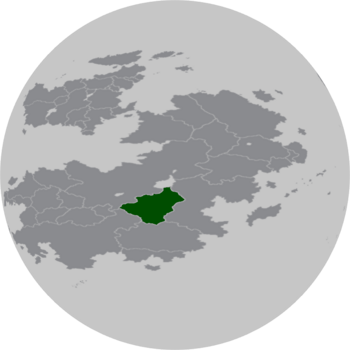Cavunia: Difference between revisions
No edit summary |
No edit summary |
||
| Line 16: | Line 16: | ||
|other_symbol_type = <!--Use if a further symbol exists, e.g. hymn--> | |other_symbol_type = <!--Use if a further symbol exists, e.g. hymn--> | ||
|other_symbol = | |other_symbol = | ||
|image_map = | |image_map = Cavunia_location_globe.png | ||
|alt_map = <!--alt text for map--> | |alt_map = <!--alt text for map--> | ||
|map_caption = Location of Cavunia in [[Kylaris]] | |map_caption = Location of Cavunia in [[Kylaris]] | ||
Revision as of 18:28, 23 December 2019
Republic of Cavunia Respublïka'sı Kavunyý | |
|---|---|
| Motto: Taklar'sı Baralý Children of the Mountains | |
| Anthem: Bırasan'qal Marching horde | |
 Location of Cavunia in Kylaris | |
| Capital | Manrıngol |
| Largest city | Aq'Hort |
| Official languages | Kunak |
| Recognised local languages | Balrik, Ibeki, Sogdhyn, Udde |
| Demonym(s) | Cavunian |
| Government | Unitary presidential Republic |
• President | Ari Maltıqa |
• Chief of the Şaqta | Ghyokso Hodönoglü |
| Senate | |
| Şaqta | |
| Establishment | |
• First Kunak state | 1178 |
• Kingdom of Öde | 1349 |
• Second Kunak state | 1526 |
• Federation of the Cavunians | 1689 |
• Unity Law | 1960 |
| Population | |
• 2019 estimate | 27,522,309 |
• 2015 census | 26,427,082 |
| GDP (PPP) | 2019 estimate |
• Total | $425,6 billion |
• Per capita | $15,463 |
| GDP (nominal) | 2019 estimate |
• Total | $215,8 billion |
• Per capita | $7,841 |
| Gini | 39.7 medium |
| HDI | 0.718 high |
| Currency | Cavunian ban (KVB) |
| Time zone | +2 |
| Driving side | right |
| Calling code | +97 |
| Internet TLD | .kv |
Cavunia (Kunak: Kavunia), formally known as the Republic of Cavunia (Kunak: Respublïka'sı Kavunyý) is a sovereign state in the central Coius, bordering Zorasan to the west and north, Dezevau to the northeast and Yi to the south. With an area of approx. 1,200,000-1,500,000 km², Cavunia is 20th - 25th biggest country in Kylaris. It's mostly a mountainous country, with over 80-90% of the area above 300 metres.
The present day Cavunia was first settled in around 4th century by various tribes that would practice nomadic lifestyle. First permament settlement appeared in 11th century, when the traders from Dezevau created a trade hub alogside some river. This in turn allowed some religions to spread into Cavunia. Up until late 17th century, various tribes fought over the control of the region, warring and raiding each other and neighbouring states. In 1689, chief of the Kunak tribe, Gölay Gölay, conquered most of the modern Cavunian territory and proclaimed himself the only leader of the newly founded federation, abandoning semi-nomadic government. Later, in 19th century, Cavunia became a tributary state of some empire and was under foreign governance up until the Great War, though, due to low population density and harsh climate, maintained a fair level of autonomy. After the Great War various clans desired to control the reborn Cavunian nation, resulting in a civili war that lasted until 1960, when the Unity Law was signed proclaiming Cavunia as a unitary republic rather than a federation, with every tribe having equal rights.
Cavunia is a presidential republic, where the president wields the most power. Current leader, Ari Maltıqa is the head of the state since 2003. The country is divided into 11 banirai and 3 töq (cities). The nation possesses a minor role in the world's politics and it has mostly neutral stance towards international incidents and issues. It's a part of Community of Nations, International Trade Organisation and International Forum for Developing States. It's a rapidly growing economy with a major industries being natural gas extraction, mining (especially iron, copper and salt), metallurgy and agriculture.
With a population of 27,522,309, Cavunia is ranked 25th - 30th in Kylaris. Most of the population inhabits north eastern areas, spread along the river, with over 4 million residing in the aglomeration of Aq'Hort. Dominant ethnic groups are Kunaks, with significant Balrik, Ibeki, Sogdhyn and Udde minorities as well. Though most people describe themselves as irreligious, Satyism and Badi are among the most well-prevailed religions.

